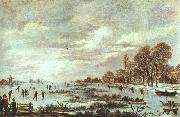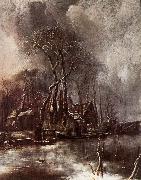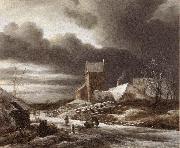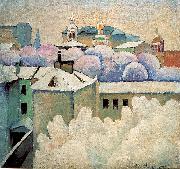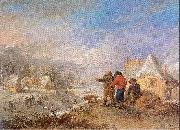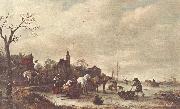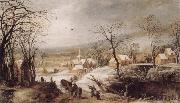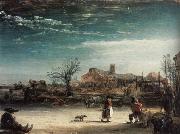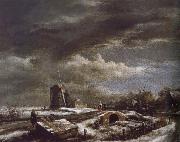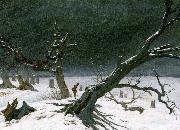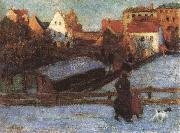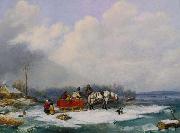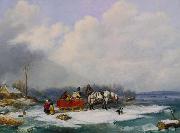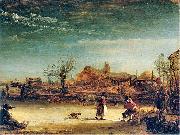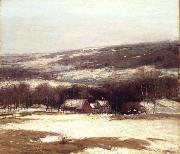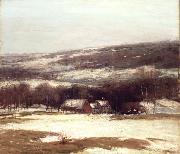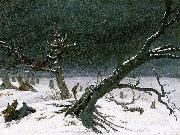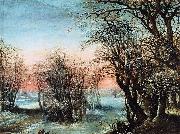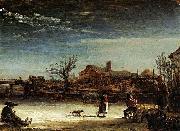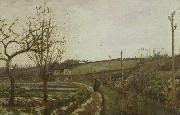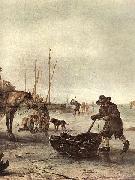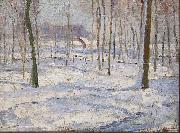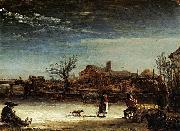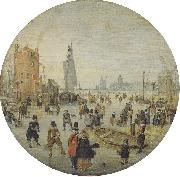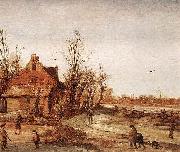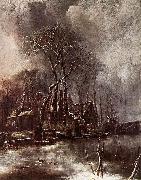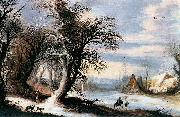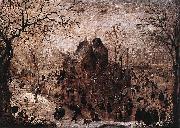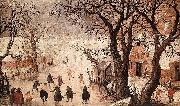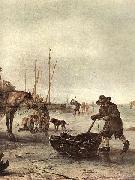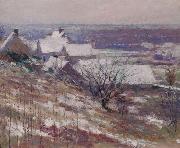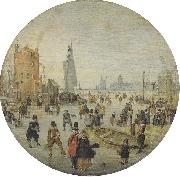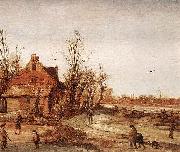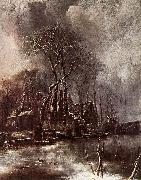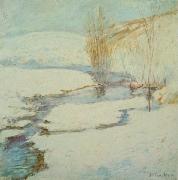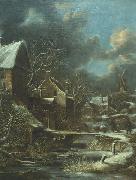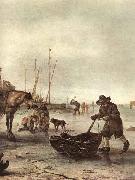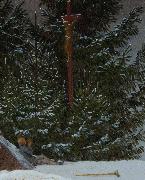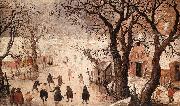Wholesale Oil Painting No Minimum |
|||||||||||
|
|
|||||||||||

|
|||||||||||
|
|
|
||||||||
Aert van der Neer1603-1677 Dutch Although generally known by the name of Aert, he usually signed himself Aernout. According to Houbraken, van der Neer spent his youth in Arkel near Gorinchem (Gorkum), a town on the river Waal, east of Dordrecht, where he worked as a majoor (steward) for the lords of Arkel. He became an amateur painter, possibly as a result of his contact with the Camphuyzen brothers Rafael Govertsz. (1597/8-1657) and Jochem Govertsz. (1601/2-59). Aert married Lysbeth Govertsdr (Liedtke) who was almost certainly Rafael and Jochem sister. Rafael acted as witness at the baptism of their daughter Cornelia in 1642. Around 1632 van der Neer and his wife moved to Amsterdam where, in about 1634, their eldest son, Eglon, was born. |
||||||||
|
|
||||||||
Winter Landscape
Winter Landscape Painting ID:: 1038 |
Pinakothek, Munich Pinakothek, Munich |
|||||||
|
|
||||||||
Jan van de Capelleseascape master Dutch Baroque Era Painter, C.1624-1679 |
||||||||
|
|
||||||||
|
|
Winter Landscape
Winter Landscape Painting ID:: 10214 |
1650Oil on wood
Rijksmuseum
Twenthe,Enschede 1650Oil on wood Rijksmuseum Twenthe,Enschede |
||||||
|
|
||||||||
Jacob van RuisdaelDutch Baroque Era Painter, ca.1628-1682 Ruysdael's favorite subjects are simple woodland scenes, similar to those of Everdingen and Hobbema. He is especially noted as a painter of trees, and his rendering of foliage, particularly of oak leaf age, is characterized by the greatest spirit and precision. His views of distant cities, such as that of Haarlem in the possession of the marquess of Bute, and that of Katwijk in the Glasgow Corporation Galleries, clearly indicate the influence of Rembrandt. He frequently painted coast-scenes and sea-pieces, but it is in his rendering of lonely forest glades that we find him at his best. The subjects of certain of his mountain scenes seem to be taken from Norway, and have led to the supposition that he had traveled in that country. We have, however, no record of such a journey, and the works in question are probably merely adaptations from the landscapes of Van Everdingen, whose manner he copied at one period. Only a single architectural subject from his brush is known--an admirable interior of the New Church, Amsterdam. The prevailing hue of his landscapes is a full rich green, which, however, has darkened with time, while a clear grey tone is characteristic of his seapieces. The art of Ruysdael, while it shows little of the scientific knowledge of later landscapists, is sensitive and poetic in sentiment, and direct and skillful in technique. Figures are sparingly introduced into his compositions, and such as occur are believed to be from the pencils of Adriaen van de Velde, Philip Wouwerman, and Jan Lingelbach. Unlike the other great Dutch landscape painters, Ruysdael did not aim at a pictorial record of particular scenes, but he carefully thought out and arranged his compositions, introducing into them an infinite variety of subtle contrasts in the formation of the clouds, the plants and tree forms, and the play of light. He particularly excelled in the painting of cloudscapes which are spanned dome-like over the landscape, and determine the light and shade of the objects. Goethe lauded him as a poet among painters, and his work shows some of the sensibilities the Romantics would later celebrate. |
||||||||
|
|
||||||||
|
|
Winter Landscape
Winter Landscape Painting ID:: 10244 |
1670 Oil on canvas
42 x 49,7 cm
Rijksmuseum,
Amsterdam 1670 Oil on canvas 42 x 49,7 cm Rijksmuseum, Amsterdam |
||||||
|
|
||||||||
Mashkov, IlyaRussian Painter, 1881-1944 was a Russian artist, one of the most significant and at the same time most characteristic painters of the circle of "Jack of Diamonds" He was born in the cossack village Mikhailovskaya-on-Don (near Volgograd) 29 July [O.S. 17 July] 1881 in a peasant family. After arriving at Moscow in 1900 he attended the Moscow School of Painting, Sculpture and Architecture, whose teachers included Konstantin Korovin and Valentin Serov. In 1909 he was expelled from the school because of his artistic free thinking. He traveled much as a student, visiting a number of the countries of West Europe, and also Turkey and Egypt. He was the member of associations "Mir iskusstva" |
||||||||
|
|
||||||||
|
|
Winter Landscape
Winter Landscape Painting ID:: 19329 |
1914
Oil on canvas
The Russian Museum, St. Petersburg. 1914 Oil on canvas The Russian Museum, St. Petersburg. |
||||||
|
|
||||||||
Michau, TheobaldFlemish Painter, 1676-1765 |
||||||||
|
|
||||||||
|
|
Winter Landscape
Winter Landscape Painting ID:: 19421 |
Galerie J.O. Leegenhoek, Paris. Galerie J.O. Leegenhoek, Paris. |
||||||
|
|
||||||||
OSTADE, Isaack vanDutch Baroque Era Painter, 1621-1649 |
||||||||
|
|
||||||||
|
|
Winter Landscape
Winter Landscape Painting ID:: 32438 |
c. 1643
Oil on wood, 71,5 x 113,5 cm c. 1643 Oil on wood, 71,5 x 113,5 cm |
||||||
|
|
||||||||
Joos de MomperFlemish Baroque Era Painter, 1564-1635 known as Josse de Momper, is one of the most important Flemish landscape painters between Pieter Brueghel the Elder and Peter Paul Rubens. Brueghel's influence is clearly evident in this many of de Momper's paintings. Born in 1564 in Antwerp, Joos de Momper was first apprenticed to his father. In the 1580s, he travelled to Italy to study art. De Momper primarily painted landscapes, the genre for which he was well-regarded during his lifetime. He painted both fantasy landscapes, viewed from a high vantage point and employing a conventional Mannerist color transition of brown in the foreground to blue and finally green in the background, and more realistic landscapes with a lower viewpoint and more natural colors. His wide panoramas also feature groups of figures. Only a small number of the 500 paintings attributed to De Momper are signed, and just one is dated. |
||||||||
|
|
||||||||
|
|
Winter Landscape
Winter Landscape Painting ID:: 33660 |
mk86
c.1620
Oil on panel
49.5x82.5cm
mk86 c.1620 Oil on panel 49.5x82.5cm |
||||||
|
|
||||||||
REMBRANDT Harmenszoon van RijnBorn 1606, Died 1669.One of the great Dutch painters and printmakers of the 17th century, Rembrandt van Rijn is best known for his expressive use of light and shadow (also called chiaroscuro) in his many portraits. Raised in Leiden, he studied with Pieter Lastman (1583-1633) in Amsterdam, then returned to Leiden around 1625 and set up shop as a teacher and portrait artist. Sometime between 1630 and 1632 Rembrandt relocated to Amsterdam, where he spent the rest of his career. Though he had his detractors (some of whom considered him coarse and "low born"), Rembrandt was successful and famous during his lifetime, though he fell on financial hard times in his later years. He was a master printer and produced hundreds of group portraits and historical paintings, including The Anatomy Lesson of Dr. Tulp (1632), The Military Company of Captain Frans Banning Cocq (1642) and Aristotle with a Bust of Homer (1653). His portraits -- including a lifelong trail of intriguing and rather frank self-portraits -- reveal his interest in psychological study and continue to be admired as landmarks in Western art. The Military Company of Captain Frans Banning Cocq is also known as "The Night Watch" because it was thought the painting depicted a nighttime scene. When the painting was cleaned in the 1940s it became obvious that it depicted a daytime scene... He married Saskia van Ulenburgh (also Uylenburgh) in 1634. |
||||||||
|
|
||||||||
|
|
Winter Landscape
Winter Landscape Painting ID:: 34479 |
mk93
1646
Oil on panel
6 5/8x9in
Gemaldegalerie,Kassel
mk93 1646 Oil on panel 6 5/8x9in Gemaldegalerie,Kassel |
||||||
|
|
||||||||
Jacob van RuisdaelDutch Baroque Era Painter, ca.1628-1682 Ruysdael's favorite subjects are simple woodland scenes, similar to those of Everdingen and Hobbema. He is especially noted as a painter of trees, and his rendering of foliage, particularly of oak leaf age, is characterized by the greatest spirit and precision. His views of distant cities, such as that of Haarlem in the possession of the marquess of Bute, and that of Katwijk in the Glasgow Corporation Galleries, clearly indicate the influence of Rembrandt. He frequently painted coast-scenes and sea-pieces, but it is in his rendering of lonely forest glades that we find him at his best. The subjects of certain of his mountain scenes seem to be taken from Norway, and have led to the supposition that he had traveled in that country. We have, however, no record of such a journey, and the works in question are probably merely adaptations from the landscapes of Van Everdingen, whose manner he copied at one period. Only a single architectural subject from his brush is known--an admirable interior of the New Church, Amsterdam. The prevailing hue of his landscapes is a full rich green, which, however, has darkened with time, while a clear grey tone is characteristic of his seapieces. The art of Ruysdael, while it shows little of the scientific knowledge of later landscapists, is sensitive and poetic in sentiment, and direct and skillful in technique. Figures are sparingly introduced into his compositions, and such as occur are believed to be from the pencils of Adriaen van de Velde, Philip Wouwerman, and Jan Lingelbach. Unlike the other great Dutch landscape painters, Ruysdael did not aim at a pictorial record of particular scenes, but he carefully thought out and arranged his compositions, introducing into them an infinite variety of subtle contrasts in the formation of the clouds, the plants and tree forms, and the play of light. He particularly excelled in the painting of cloudscapes which are spanned dome-like over the landscape, and determine the light and shade of the objects. Goethe lauded him as a poet among painters, and his work shows some of the sensibilities the Romantics would later celebrate. |
||||||||
|
|
||||||||
|
|
Winter Landscape
Winter Landscape Painting ID:: 50075 |
mk207
Signed,lower right
Late 1660s
Canvas
5.2x68.6cm
mk207 Signed,lower right Late 1660s Canvas 5.2x68.6cm |
||||||
|
|
||||||||
Caspar David Friedrich1774-1840 Caspar David Friedrich Locations German painter, studied art at Copenhagen, and in 1798 settled in Dresden. Friedrich painted chiefly landscapes and seascapes, with and without figures, architectural pictures, including a few of Dresden, and some religious subjects. Religious feeling and symbolism permeate his œuvre, of which the seascape with figures, Die Lebensstufen, is a characteristic example. He possessed considerable power to convey mood in landscape. Almost forgotten in the 19th c. and early 20th c., interest in his work increased considerably in the mid-20th c. He is hardly represented in Britain, but an exhibition of 112 of his pictures at the Tate Gallery in 1972 attracted much attention. F. G. Kersting was a friend of Friedrich. |
||||||||
|
|
||||||||
|
|
Winter Landscape
Winter Landscape Painting ID:: 52599 |
1811 Oil on canvas, 33 x 46 cm 1811 Oil on canvas, 33 x 46 cm |
||||||
|
|
||||||||
Wassily Kandinsky1866-1944 Wassily Kandinsky Galleries was a Russian painter, printmaker and art theorist. One of the most famous 20th-century artists, he is credited with painting the first modern abstract works. Born in Moscow, Kandinsky spent his childhood in Odessa. He enrolled at the University of Moscow and chose to study law and economics. Quite successful in his profession??he was offered a professorship (chair of Roman Law) at the University of Dorpat??he started painting studies (life-drawing, sketching and anatomy) at the age of 30. In 1896 he settled in Munich and studied first in the private school of Anton Azbe and then at the Academy of Fine Arts, Munich. He went back to Moscow in 1914 after World War I started. He was unsympathetic to the official theories on art in Moscow and returned to Germany in 1921. There he taught at the Bauhaus school of art and architecture from 1922 until the Nazis closed it in 1933. He then moved to France where he lived the rest of his life, and became a French citizen in 1939. He died at Neuilly-sur-Seine in 1944. |
||||||||
|
|
||||||||
|
|
Winter Landscape
Winter Landscape Painting ID:: 54994 |
mk239
1901
Oil on canvas
30.4x40.4cm
mk239 1901 Oil on canvas 30.4x40.4cm |
||||||
|
|
||||||||
Cornelius KrieghoffDutch-born Canadian Painter, 1815-1872 Canadian painter of Dutch birth. He learnt the rudiments of music and painting from his father and about 1830 attended the Akademie der Bildenden Kenste in D?sseldorf. He moved to America c. 1835 and enlisted in the US army. In New York he met Louise Gauthier, a French-Canadian, and settled in Montreal with her in 1840, working as a painter and a musician. In 1842-3 he had a studio in Rochester, NY; in the following year he studied in Paris, making copies in the Louvre. Returning to Canada in 1845, he painted portraits in Toronto, and from 1845 to 1853 he lived in Longueuil and then in Montreal, where he produced genre paintings, landscapes and portraits. He exhibited in Montreal and Toronto, and a series of lithographs were published after his drawings. However, he found it difficult to sell his work in Montreal and had to resort more or less completely to sign-painting for a living. About 1853, at the instigation of the auctioneer John Budden, Krieghoff settled in Quebec City. He lived there for 11 years, making several trips to Europe. During this period of intensive production, he achieved popularity and prosperity and painted his best-known pictures, which were scenes depicting the local townspeople and the North American Indians, and views of Quebec City and the surrounding region. About 1858 he made panoramic paintings of Canada for the Provincial Parliament buildings in Quebec. From 1864 to 1867 he lived in Paris and Munich, |
||||||||
|
|
||||||||
|
|
Winter Landscape
Winter Landscape Painting ID:: 65387 |
oil on canvas painting by Cornelius Krieghoff, 1849, National Gallery of Canada oil on canvas painting by Cornelius Krieghoff, 1849, National Gallery of Canada |
||||||
|
|
||||||||
Cornelius KrieghoffDutch-born Canadian Painter, 1815-1872 Canadian painter of Dutch birth. He learnt the rudiments of music and painting from his father and about 1830 attended the Akademie der Bildenden Kenste in D?sseldorf. He moved to America c. 1835 and enlisted in the US army. In New York he met Louise Gauthier, a French-Canadian, and settled in Montreal with her in 1840, working as a painter and a musician. In 1842-3 he had a studio in Rochester, NY; in the following year he studied in Paris, making copies in the Louvre. Returning to Canada in 1845, he painted portraits in Toronto, and from 1845 to 1853 he lived in Longueuil and then in Montreal, where he produced genre paintings, landscapes and portraits. He exhibited in Montreal and Toronto, and a series of lithographs were published after his drawings. However, he found it difficult to sell his work in Montreal and had to resort more or less completely to sign-painting for a living. About 1853, at the instigation of the auctioneer John Budden, Krieghoff settled in Quebec City. He lived there for 11 years, making several trips to Europe. During this period of intensive production, he achieved popularity and prosperity and painted his best-known pictures, which were scenes depicting the local townspeople and the North American Indians, and views of Quebec City and the surrounding region. About 1858 he made panoramic paintings of Canada for the Provincial Parliament buildings in Quebec. From 1864 to 1867 he lived in Paris and Munich, |
||||||||
|
|
||||||||
|
|
Winter Landscape
Winter Landscape Painting ID:: 69641 |
oil on canvas painting by Cornelius Krieghoff, , National Gallery of Canada oil on canvas painting by Cornelius Krieghoff, , National Gallery of Canada |
||||||
|
|
||||||||
Rembrandt Peale1778-1860 Rembrandt Peale Galleries Rembrandt Peale (February 22, 1778 ?C October 3, 1860) was a 19th century American artist that received critical acclaim for his portraits of presidents George Washington and Thomas Jefferson. Although modern art critics would consider Peale??s artwork as French neoclassical, its dark and stylized characteristics are similar to 15th and 16th century paintings. Rembrandt Peale was born the third of six surviving children (eleven had died) to his mother, Rachel Brewer, and father, Charles Willson Peale in Bucks County, Pennsylvania, on February 22, 1778. The father, Charles, also a notable artist, taught each child to paint scenery and portraiture, and Rembrandt was no exception. Charles tutored Rembrandt about the importance of having a strong mind from learning arts and sciences. At the age of eight, Rembrandt discovered drawing, and at thirteen, painted his first known self-portrait. Later on in his life, Rembrandt Peale "often showed this painting to young beginners, to encourage them to go from 'bad' to better..." like his steady progressions to become a successful portraitist. A year after his mother??s death and remarriage of his father, Rembrandt Peale left the school of the arts, thereby applying his time to completing his first ever self-portrait at the age of 13. The canvas illustrates early mastery of a young aspiring artist, seeming very mature. The clothes, however give the notion that Peale over-exaggerated what a 13 year old would look like. This style demonstrates early forms of neoclassicism by the looks of Peale's angel-like hair, the way it waves and curls in such a fashion so as to depict an angel from a general Renaissance artist's works of art. In July of 1787, Charles Willson Peale introduced his son Rembrandt to George Washington, where the young aspirant artist watched his father paint the remarkable figure of the country. In 1795, at the age of 17, Rembrandt painted an aging Washington, though the painter had depicted the politician as far more aged than the original facial characteristics. It did, nevertheless attain praise and Rembrandt had begun his debut. At the age of 20, Rembrandt married 22-year-old Eleanor May Short (1776-1836) at St. Joseph's Catholic Church in Philadelphia. During their marriage, Rembrandt and Eleanor had nine children: Rosalba, Eleanor, Sarah Miriam, Michael Angelo, and Emma Clara among them. In 1822, Peale moved to New York City where he embarked on an attempt to paint what he hoped would become the "standard likeness" of Washington. He studied portraits by other artists including John Trumbull, Gilbert Stuart and his own father, as well as his own 1795 picture which had never truly satisfied him. His resulting work Patriae Pater, completed in 1824, depicts Washington through an oval window, and is considered by many to be second only to Gilbert Stuart's iconic Athenaeum painting of the first president. Peale subsequently attempted to capitalize on the success of what quickly became known as his "Porthole" picture. Patriae Pater was purchased by Congress in 1832 and still hangs in the U.S. Capitol. Later on, Peale made over 70 detailed replicas of the same "father of our country", the first President of the United States. Peale continued to paint other noted portraits, such as those of the third president Thomas Jefferson while he was in office (1805), and later on a portrait of Chief Justice John Marshall. |
||||||||
|
|
||||||||
|
|
Winter landscape
Winter landscape Painting ID:: 70692 |
Medium Oil on oak panel
Dimensions Expression error: Missing operand for *17 ?? 23 cm
Medium Oil on oak panel Dimensions Expression error: Missing operand for *17 ?? 23 cm |
||||||
|
|
||||||||
Alexander Theobald Van LaerAlexander Theobald Van Laer (1857-1920) was an American painter, born at Auburn, New York. He studied at the Art Students League of New York |
||||||||
|
|
||||||||
|
|
Winter Landscape
Winter Landscape Painting ID:: 71433 |
ca. 1907(1907)
Oil on canvas
81.8 x 71 cm (32.2 x 27.95 in)
ca. 1907(1907) Oil on canvas 81.8 x 71 cm (32.2 x 27.95 in) |
||||||
|
|
||||||||
Alexander Theobald Van LaerAlexander Theobald Van Laer (1857-1920) was an American painter, born at Auburn, New York. He studied at the Art Students League of New York |
||||||||
|
|
||||||||
|
|
Winter Landscape
Winter Landscape Painting ID:: 72568 |
Date ca. 1907(1907)
Medium Oil on canvas
Dimensions 81.8 X 71 cm (32.2 X 27.95 in)
cyf Date ca. 1907(1907) Medium Oil on canvas Dimensions 81.8 X 71 cm (32.2 X 27.95 in) cyf |
||||||
|
|
||||||||
Caspar David Friedrich1774-1840 Caspar David Friedrich Locations German painter, studied art at Copenhagen, and in 1798 settled in Dresden. Friedrich painted chiefly landscapes and seascapes, with and without figures, architectural pictures, including a few of Dresden, and some religious subjects. Religious feeling and symbolism permeate his œuvre, of which the seascape with figures, Die Lebensstufen, is a characteristic example. He possessed considerable power to convey mood in landscape. Almost forgotten in the 19th c. and early 20th c., interest in his work increased considerably in the mid-20th c. He is hardly represented in Britain, but an exhibition of 112 of his pictures at the Tate Gallery in 1972 attracted much attention. F. G. Kersting was a friend of Friedrich. |
||||||||
|
|
||||||||
|
|
Winter Landscape
Winter Landscape Painting ID:: 73868 |
Winter Landscape
1811
cjr Winter Landscape 1811 cjr |
||||||
|
|
||||||||
Denys Van AlslootMalines 1570-Brussels 1628 |
||||||||
|
|
||||||||
|
|
Winter Landscape
Winter Landscape Painting ID:: 76451 |
Date 1610(1610)
Medium Oil on wood
cyf Date 1610(1610) Medium Oil on wood cyf |
||||||
|
|
||||||||
REMBRANDT Harmenszoon van RijnBorn 1606, Died 1669.One of the great Dutch painters and printmakers of the 17th century, Rembrandt van Rijn is best known for his expressive use of light and shadow (also called chiaroscuro) in his many portraits. Raised in Leiden, he studied with Pieter Lastman (1583-1633) in Amsterdam, then returned to Leiden around 1625 and set up shop as a teacher and portrait artist. Sometime between 1630 and 1632 Rembrandt relocated to Amsterdam, where he spent the rest of his career. Though he had his detractors (some of whom considered him coarse and "low born"), Rembrandt was successful and famous during his lifetime, though he fell on financial hard times in his later years. He was a master printer and produced hundreds of group portraits and historical paintings, including The Anatomy Lesson of Dr. Tulp (1632), The Military Company of Captain Frans Banning Cocq (1642) and Aristotle with a Bust of Homer (1653). His portraits -- including a lifelong trail of intriguing and rather frank self-portraits -- reveal his interest in psychological study and continue to be admired as landmarks in Western art. The Military Company of Captain Frans Banning Cocq is also known as "The Night Watch" because it was thought the painting depicted a nighttime scene. When the painting was cleaned in the 1940s it became obvious that it depicted a daytime scene... He married Saskia van Ulenburgh (also Uylenburgh) in 1634. |
||||||||
|
|
||||||||
|
|
Winter Landscape
Winter Landscape Painting ID:: 80813 |
Date 1646(1646)
Medium Oil on oak
Dimensions Height: 17 cm (6.7 in). Width: 23 cm (9.1 in).
cjr Date 1646(1646) Medium Oil on oak Dimensions Height: 17 cm (6.7 in). Width: 23 cm (9.1 in). cjr |
||||||
|
|
||||||||
Camille PissarroCaribbean-born French Pointillist/Impressionist Painter, ca.1830-1903 .Painter and printmaker. He was the only painter to exhibit in all eight of the Impressionist exhibitions held between 1874 and 1886, and he is often regarded as the 'father' of the movement. He was by no means narrow in outlook, however, and throughout his life remained as radical in artistic matters as he was in politics. Thad?e Natanson wrote in 1948: 'Nothing of novelty or of excellence appeared that Pissarro had not been among the first, if not the very first, to discern and to defend.' The significance of Pissarro's work is in the balance maintained between tradition and the avant-garde. Octave Mirbeau commented: 'M. Camille Pissarro has shown himself to be a revolutionary by renewing the art of painting in a purely working sense; |
||||||||
|
|
||||||||
|
|
Winter Landscape
Winter Landscape Painting ID:: 82141 |
Date 1873(1873)
Medium Oil on canvas
Dimensions 52 x 81 cm (20.5 x 31.9 in)
cjr Date 1873(1873) Medium Oil on canvas Dimensions 52 x 81 cm (20.5 x 31.9 in) cjr |
||||||
|
|
||||||||
Isaac van Ostade(bapt. June 2, 1621, Haarlem - buried October 16, 1649, Haarlem) was a Dutch genre and landscape painter. Van Ostade began his studies under his brother, Adriaen, with whom he remained till 1641, when he started his own practice. At an early period he felt the influence of Rembrandt, and this is apparent in a Slaughtered Pig of 1639, in the gallery of Augsburg. He soon found a style more suited to his own inclinations. He produced pictures in 1641-1642 on the lines of his brother - amongst these, the Five Senses, which Adrian afterwards represented by a Man reading a Paper, a Peasant tasting Beer, a Rustic smearing his Sores with Ointment and a Countryman sniffing at a Snuff-box. A specimen of Isaac's work at this period may be seen in the Laughing Boor with a Pot of Beer, in the museum of Amsterdam; the cottage interior, with two peasants and three children near a fire, in the Berlin museum; a Concert, with people listening to singers accompanied by a piper and flute player, and a Boor stealing a Kiss from a Woman, in the Lacaze collection at the Louvre. The interior at Berlin is lighted from a casement in the same Rembrandtesque style as Adrian's interior of 1643 at the Louvre. He received low prices for this kind of painting, in which he could only remain subordinate to his brother. Gradually he abandoned Adrian's cottage subjects for landscapes in the fashion of Esaias van de Velde and Salomon van Ruysdael. Once only, in 1645, he reverted to the earlier mode, when he produced the Slaughtered Pig, with a boy puffing out a bladder, in the museum of Lille. Isaac's progress in his new path was greatly facilitated by his previous experience as a figure painter; and, although he now selected his subjects either from village high streets or frozen canals, he gave fresh life to the scenes by depicting animated groups of people with a refined and searching study of picturesque contrasts. He did not live long enough to bring his art to the highest perfection. He died on 16 October 1649 having painted about 400 pictures (see H de Groot, 1910). The first manifestation of Isaac's surrender of Adrian's style is apparent in 1644 when the skating and sledging scenes were executed which we see in the Lacaze collection and the galleries of the Hermitage, Antwerp and Lille. Three of these examples bear the artists name, spelled Isack van Ostade, and the dates of 1644 and 1645. The roadside inns, with halts of travellers, form a compact series from 1646 to 1649. This is the last form of Isaac's art and has very distinct peculiarities. The air which pervades his composition is warm and sunny, yet mellow and hazy, as if the sky were veiled with a vapour coloured by moor smoke. The trees are rubbings of umber, in which the prominent foliage is tipped with touches hardened in a liquid state by amber varnish mediums. The same principle applied to details such asglazed bricks or rents in the mud lining of cottages gives an unreal and conventional stamp to them. These quirks are overcome by his broad contrasts of light and shade and the masterly figures of horses, riders, travellers, rustics, quarrelling children, dogs, poultry and cattle. A favorite place is always given to the white horse, which seems as invariable an accompaniment as the grey in the skirmishes and fairs of Philip Wouwerman. Isaac displays the best qualities in winter scenes. The absence of foliage, the crisp atmosphere and the calm air of cold January days, unsullied by smoke or vapour, preclude the use of the brown tinge, and leave the painter no choice but to ring the changes with a great variety of opal tints. Then the figures emerge with masterly effect on the light background. Amongst the roadside inns it is worth noting those in the collections of Buckingham Palace, the National Gallery, London, the Wallace Collection and Holford collections in England, the Louvre, Berlin, Hermitage and Rotterdam museums and the Rothschild collection at Vienna. The finest of the ice scenes is the famous one at the Louvre. |
||||||||
|
|
||||||||
|
|
Winter Landscape
Winter Landscape Painting ID:: 83959 |
Date ca. 1643(1643)
Medium Oil on wood
cjr Date ca. 1643(1643) Medium Oil on wood cjr |
||||||
|
|
||||||||
Georges Buyssepainted Winter Landscape in 19th century |
||||||||
|
|
||||||||
|
|
Winter Landscape
Winter Landscape Painting ID:: 84254 |
Date 19th century
Medium Oil on panel
Dimensions 26.5 x 36.5 cm (10.4 x 14.4 in)
cjr Date 19th century Medium Oil on panel Dimensions 26.5 x 36.5 cm (10.4 x 14.4 in) cjr |
||||||
|
|
||||||||
Rembrandt Peale1778-1860 Rembrandt Peale Galleries Rembrandt Peale (February 22, 1778 ?C October 3, 1860) was a 19th century American artist that received critical acclaim for his portraits of presidents George Washington and Thomas Jefferson. Although modern art critics would consider Peale??s artwork as French neoclassical, its dark and stylized characteristics are similar to 15th and 16th century paintings. Rembrandt Peale was born the third of six surviving children (eleven had died) to his mother, Rachel Brewer, and father, Charles Willson Peale in Bucks County, Pennsylvania, on February 22, 1778. The father, Charles, also a notable artist, taught each child to paint scenery and portraiture, and Rembrandt was no exception. Charles tutored Rembrandt about the importance of having a strong mind from learning arts and sciences. At the age of eight, Rembrandt discovered drawing, and at thirteen, painted his first known self-portrait. Later on in his life, Rembrandt Peale "often showed this painting to young beginners, to encourage them to go from 'bad' to better..." like his steady progressions to become a successful portraitist. A year after his mother??s death and remarriage of his father, Rembrandt Peale left the school of the arts, thereby applying his time to completing his first ever self-portrait at the age of 13. The canvas illustrates early mastery of a young aspiring artist, seeming very mature. The clothes, however give the notion that Peale over-exaggerated what a 13 year old would look like. This style demonstrates early forms of neoclassicism by the looks of Peale's angel-like hair, the way it waves and curls in such a fashion so as to depict an angel from a general Renaissance artist's works of art. In July of 1787, Charles Willson Peale introduced his son Rembrandt to George Washington, where the young aspirant artist watched his father paint the remarkable figure of the country. In 1795, at the age of 17, Rembrandt painted an aging Washington, though the painter had depicted the politician as far more aged than the original facial characteristics. It did, nevertheless attain praise and Rembrandt had begun his debut. At the age of 20, Rembrandt married 22-year-old Eleanor May Short (1776-1836) at St. Joseph's Catholic Church in Philadelphia. During their marriage, Rembrandt and Eleanor had nine children: Rosalba, Eleanor, Sarah Miriam, Michael Angelo, and Emma Clara among them. In 1822, Peale moved to New York City where he embarked on an attempt to paint what he hoped would become the "standard likeness" of Washington. He studied portraits by other artists including John Trumbull, Gilbert Stuart and his own father, as well as his own 1795 picture which had never truly satisfied him. His resulting work Patriae Pater, completed in 1824, depicts Washington through an oval window, and is considered by many to be second only to Gilbert Stuart's iconic Athenaeum painting of the first president. Peale subsequently attempted to capitalize on the success of what quickly became known as his "Porthole" picture. Patriae Pater was purchased by Congress in 1832 and still hangs in the U.S. Capitol. Later on, Peale made over 70 detailed replicas of the same "father of our country", the first President of the United States. Peale continued to paint other noted portraits, such as those of the third president Thomas Jefferson while he was in office (1805), and later on a portrait of Chief Justice John Marshall. |
||||||||
|
|
||||||||
|
|
Winter Landscape
Winter Landscape Painting ID:: 84989 |
1646(1646)
Medium Oil on oak
cyf 1646(1646) Medium Oil on oak cyf |
||||||
|
|
||||||||
Hendrick Avercamp1585-1634 Dutch Hendrick Avercamp Galleries Hendrick Avercamp (bapt. January 27, 1585, Amsterdam - buried May 15, 1634, Kampen (Overijssel)) was a Dutch painter. Avercamp studied in Amsterdam with the Danish-born portrait painter Pieter Isaacks (1569-1625), and perhaps also with David Vinckbooms. In 1608 he moved from Amsterdam to Kampen in the province of Overijssel. Avercamp was deaf and was known as "de Stomme van Kampen" (the mute of Kampen). As one of the first landscape painters of the 17th-century Dutch school, he specialized in painting the Netherlands in winter. Avercamp's paintings are colorful and lively, with carefully crafted images of the people in the landscape. Avercamp's work enjoyed great popularity and he sold his drawings, many of which were tinted with water-color, as finished pictures to be pasted into the albums of collectors. Queen Elizabeth II has an outstanding collection of his works at Windsor Castle, England. |
||||||||
|
|
||||||||
|
|
Winter landscape
Winter landscape Painting ID:: 85482 |
Oil on wood
Dimensions ∅18,2 cm
cjr Oil on wood Dimensions ∅18,2 cm cjr |
||||||
|
|
||||||||
Esaias Van de Velde1591-1630 Dutch Esaias Van de Velde Gallery Painter, draughtsman and etcher. He probably received his earliest training from his father. It is also possible that he studied with the Antwerp painter Gillis van Coninxloo, who moved to Amsterdam in 1595 (ten years after Esaias father). He may also have trained with David Vinckboons, whose work shows similarities with that of Esaias. Esaias became a member of the Haarlem Guild of St Luke in 1612, the same year as Willem Buytewech and the landscape painter Hercules Segers. During this Haarlem period Esaias had two pupils, Jan van Goyen and Pieter de Neijn (1597-1639), but by 1618 he had moved with his family to The Hague, where he joined the Guild of St Luke in October of that year. |
||||||||
|
|
||||||||
|
|
Winter Landscape
Winter Landscape Painting ID:: 85583 |
Date 1623(1623)
Medium Oil on wood
Dimensions Height: 25.9 cm (10.2 in). Width: 30.4 cm (12 in).
cjr Date 1623(1623) Medium Oil on wood Dimensions Height: 25.9 cm (10.2 in). Width: 30.4 cm (12 in). cjr |
||||||
|
|
||||||||
Jan van de Cappelle1624-1679 Dutch Jan van de Cappelle Locations Dutch businessman, collector, painter, draughtsman and etcher. Though now considered the outstanding marine painter of 17th-century Holland, he was not a professional artist nor a member of the Amsterdam Guild of St Luke. His father owned a successful dye-works in Amsterdam, in which both Jan and his brother Louis were active. Their father enjoyed a long life and probably managed the firm until close to his death in 1674, when Jan inherited it. This left Jan with plenty of spare time to pursue his hobby, painting. He married Annetje Jansdr. (Anna Grotingh) before 1653. He died a widower, survived by his seven children, who inherited his considerable fortune. His last will shows that in addition to the dye-works and immense cash assets, van de Cappelle owned extensive properties and an art collection that must be rated among the most important of his time. |
||||||||
|
|
||||||||
|
|
Winter Landscape
Winter Landscape Painting ID:: 85799 |
Date 1650s
Medium Oil on wood
cjr Date 1650s Medium Oil on wood cjr |
||||||
|
|
||||||||
Gijsbrecht Leytens(1586-1643 or 1656), also known as The Master of the Winter Landscapes, was a Flemish Baroque painter who specialized in winter landscapes influenced by Jan Brueghel the Elder and Gillis van Coninxloo. He became a master in Antwerp's guild of St. Luke in 1611, but little else is known of his career. Like his contemporaries in Antwerp, Abraham Govaerts and Alexander Keirincx, Leytens painted wooded landscapes populated with small figures, bracketed by strong repoussoir trees. His paintings, however, were generally winter scenes, a recognized specialty known as a Winterken ("little winter"). |
||||||||
|
|
||||||||
|
|
Winter Landscape
Winter Landscape Painting ID:: 86369 |
Date first half of 17th century
Medium Oil on oak panel
Dimensions Height: 42 cm (16.5 in). Width: 64 cm (25.2 in).
cjr Date first half of 17th century Medium Oil on oak panel Dimensions Height: 42 cm (16.5 in). Width: 64 cm (25.2 in). cjr |
||||||
|
|
||||||||
Hendrick Avercamp1585-1634 Dutch Hendrick Avercamp Galleries Hendrick Avercamp (bapt. January 27, 1585, Amsterdam - buried May 15, 1634, Kampen (Overijssel)) was a Dutch painter. Avercamp studied in Amsterdam with the Danish-born portrait painter Pieter Isaacks (1569-1625), and perhaps also with David Vinckbooms. In 1608 he moved from Amsterdam to Kampen in the province of Overijssel. Avercamp was deaf and was known as "de Stomme van Kampen" (the mute of Kampen). As one of the first landscape painters of the 17th-century Dutch school, he specialized in painting the Netherlands in winter. Avercamp's paintings are colorful and lively, with carefully crafted images of the people in the landscape. Avercamp's work enjoyed great popularity and he sold his drawings, many of which were tinted with water-color, as finished pictures to be pasted into the albums of collectors. Queen Elizabeth II has an outstanding collection of his works at Windsor Castle, England. |
||||||||
|
|
||||||||
|
|
Winter Landscape
Winter Landscape Painting ID:: 86939 |
between 1605(1605) and 1610(1610)
Medium Oil on oak
cyf between 1605(1605) and 1610(1610) Medium Oil on oak cyf |
||||||
|
|
||||||||
Hendrick Avercamp1585-1634 Dutch Hendrick Avercamp Galleries Hendrick Avercamp (bapt. January 27, 1585, Amsterdam - buried May 15, 1634, Kampen (Overijssel)) was a Dutch painter. Avercamp studied in Amsterdam with the Danish-born portrait painter Pieter Isaacks (1569-1625), and perhaps also with David Vinckbooms. In 1608 he moved from Amsterdam to Kampen in the province of Overijssel. Avercamp was deaf and was known as "de Stomme van Kampen" (the mute of Kampen). As one of the first landscape painters of the 17th-century Dutch school, he specialized in painting the Netherlands in winter. Avercamp's paintings are colorful and lively, with carefully crafted images of the people in the landscape. Avercamp's work enjoyed great popularity and he sold his drawings, many of which were tinted with water-color, as finished pictures to be pasted into the albums of collectors. Queen Elizabeth II has an outstanding collection of his works at Windsor Castle, England. |
||||||||
|
|
||||||||
|
|
Winter Landscape
Winter Landscape Painting ID:: 86940 |
first half of 17th century
Medium Oil on wood
cyf first half of 17th century Medium Oil on wood cyf |
||||||
|
|
||||||||
Isaac van Ostade(bapt. June 2, 1621, Haarlem - buried October 16, 1649, Haarlem) was a Dutch genre and landscape painter. Van Ostade began his studies under his brother, Adriaen, with whom he remained till 1641, when he started his own practice. At an early period he felt the influence of Rembrandt, and this is apparent in a Slaughtered Pig of 1639, in the gallery of Augsburg. He soon found a style more suited to his own inclinations. He produced pictures in 1641-1642 on the lines of his brother - amongst these, the Five Senses, which Adrian afterwards represented by a Man reading a Paper, a Peasant tasting Beer, a Rustic smearing his Sores with Ointment and a Countryman sniffing at a Snuff-box. A specimen of Isaac's work at this period may be seen in the Laughing Boor with a Pot of Beer, in the museum of Amsterdam; the cottage interior, with two peasants and three children near a fire, in the Berlin museum; a Concert, with people listening to singers accompanied by a piper and flute player, and a Boor stealing a Kiss from a Woman, in the Lacaze collection at the Louvre. The interior at Berlin is lighted from a casement in the same Rembrandtesque style as Adrian's interior of 1643 at the Louvre. He received low prices for this kind of painting, in which he could only remain subordinate to his brother. Gradually he abandoned Adrian's cottage subjects for landscapes in the fashion of Esaias van de Velde and Salomon van Ruysdael. Once only, in 1645, he reverted to the earlier mode, when he produced the Slaughtered Pig, with a boy puffing out a bladder, in the museum of Lille. Isaac's progress in his new path was greatly facilitated by his previous experience as a figure painter; and, although he now selected his subjects either from village high streets or frozen canals, he gave fresh life to the scenes by depicting animated groups of people with a refined and searching study of picturesque contrasts. He did not live long enough to bring his art to the highest perfection. He died on 16 October 1649 having painted about 400 pictures (see H de Groot, 1910). The first manifestation of Isaac's surrender of Adrian's style is apparent in 1644 when the skating and sledging scenes were executed which we see in the Lacaze collection and the galleries of the Hermitage, Antwerp and Lille. Three of these examples bear the artists name, spelled Isack van Ostade, and the dates of 1644 and 1645. The roadside inns, with halts of travellers, form a compact series from 1646 to 1649. This is the last form of Isaac's art and has very distinct peculiarities. The air which pervades his composition is warm and sunny, yet mellow and hazy, as if the sky were veiled with a vapour coloured by moor smoke. The trees are rubbings of umber, in which the prominent foliage is tipped with touches hardened in a liquid state by amber varnish mediums. The same principle applied to details such asglazed bricks or rents in the mud lining of cottages gives an unreal and conventional stamp to them. These quirks are overcome by his broad contrasts of light and shade and the masterly figures of horses, riders, travellers, rustics, quarrelling children, dogs, poultry and cattle. A favorite place is always given to the white horse, which seems as invariable an accompaniment as the grey in the skirmishes and fairs of Philip Wouwerman. Isaac displays the best qualities in winter scenes. The absence of foliage, the crisp atmosphere and the calm air of cold January days, unsullied by smoke or vapour, preclude the use of the brown tinge, and leave the painter no choice but to ring the changes with a great variety of opal tints. Then the figures emerge with masterly effect on the light background. Amongst the roadside inns it is worth noting those in the collections of Buckingham Palace, the National Gallery, London, the Wallace Collection and Holford collections in England, the Louvre, Berlin, Hermitage and Rotterdam museums and the Rothschild collection at Vienna. The finest of the ice scenes is the famous one at the Louvre. |
||||||||
|
|
||||||||
|
|
Winter Landscape
Winter Landscape Painting ID:: 87811 |
1643(1643)
Medium Oil on wood
cyf 1643(1643) Medium Oil on wood cyf |
||||||
|
|
||||||||
Theodore Robinson1852-1896 Theodore Robinson (July 3, 1852 ?C April 2, 1896) was an American painter best known for his impressionist landscapes. He was one of the first American artists to take up impressionism in the late 1880s, visiting Giverny and developing a close friendship with Claude Monet. Several of his works are considered masterpieces of American Impressionism. In 1884 Robinson returned to France where he would live for the next eight years, visiting America only occasionally. Robinson gravitated to Giverny, which had become a center of French impressionist art under the influence of Claude Monet. La Debacle, 1892, collection: Scripps College, Claremont, CaliforniaHistorians are unclear when Robinson met Monet, but by 1888 their friendship was enough for Robinson to move in next door to the famous impressionist. Robinson's art shifted to a more traditional impressionistic manner during this time, likely due to Monet's influence. While a number of American artists had gathered at Giverny, none were as close to Monet as Robinson. Monet offered advice to Robinson, and he likewise solicited Robinson for opinions on Monet's own works in progress. At Giverny, Robinson painted what art historians regard as some of his finest works. These depicted the surrounding countryside in different weather, in the plein air tradition, sometimes with women shown in leisurely poses. An example of his mature work during this period is La Debacle (1892) in the collection of Scripps College, Claremont California. |
||||||||
|
|
||||||||
|
|
Winter Landscape
Winter Landscape Painting ID:: 88505 |
1889(1889)
Medium English: oil on canvas
Dimensions Deutsch: 46.4 x 55.9 cm
cjr 1889(1889) Medium English: oil on canvas Dimensions Deutsch: 46.4 x 55.9 cm cjr |
||||||
|
|
||||||||
Hendrick Avercamp1585-1634 Dutch Hendrick Avercamp Galleries Hendrick Avercamp (bapt. January 27, 1585, Amsterdam - buried May 15, 1634, Kampen (Overijssel)) was a Dutch painter. Avercamp studied in Amsterdam with the Danish-born portrait painter Pieter Isaacks (1569-1625), and perhaps also with David Vinckbooms. In 1608 he moved from Amsterdam to Kampen in the province of Overijssel. Avercamp was deaf and was known as "de Stomme van Kampen" (the mute of Kampen). As one of the first landscape painters of the 17th-century Dutch school, he specialized in painting the Netherlands in winter. Avercamp's paintings are colorful and lively, with carefully crafted images of the people in the landscape. Avercamp's work enjoyed great popularity and he sold his drawings, many of which were tinted with water-color, as finished pictures to be pasted into the albums of collectors. Queen Elizabeth II has an outstanding collection of his works at Windsor Castle, England. |
||||||||
|
|
||||||||
|
|
Winter landscape
Winter landscape Painting ID:: 89597 |
Oil on wood
Dimensions ∅18,2 cm
cyf Oil on wood Dimensions ∅18,2 cm cyf |
||||||
|
|
||||||||
Esaias Van de Velde1591-1630 Dutch Esaias Van de Velde Gallery Painter, draughtsman and etcher. He probably received his earliest training from his father. It is also possible that he studied with the Antwerp painter Gillis van Coninxloo, who moved to Amsterdam in 1595 (ten years after Esaias father). He may also have trained with David Vinckboons, whose work shows similarities with that of Esaias. Esaias became a member of the Haarlem Guild of St Luke in 1612, the same year as Willem Buytewech and the landscape painter Hercules Segers. During this Haarlem period Esaias had two pupils, Jan van Goyen and Pieter de Neijn (1597-1639), but by 1618 he had moved with his family to The Hague, where he joined the Guild of St Luke in October of that year. |
||||||||
|
|
||||||||
|
|
Winter Landscape
Winter Landscape Painting ID:: 89670 |
1623(1623)
Medium oil on panel
cyf 1623(1623) Medium oil on panel cyf |
||||||
|
|
||||||||
Jan van de Cappelle1624-1679 Dutch Jan van de Cappelle Locations Dutch businessman, collector, painter, draughtsman and etcher. Though now considered the outstanding marine painter of 17th-century Holland, he was not a professional artist nor a member of the Amsterdam Guild of St Luke. His father owned a successful dye-works in Amsterdam, in which both Jan and his brother Louis were active. Their father enjoyed a long life and probably managed the firm until close to his death in 1674, when Jan inherited it. This left Jan with plenty of spare time to pursue his hobby, painting. He married Annetje Jansdr. (Anna Grotingh) before 1653. He died a widower, survived by his seven children, who inherited his considerable fortune. His last will shows that in addition to the dye-works and immense cash assets, van de Cappelle owned extensive properties and an art collection that must be rated among the most important of his time. |
||||||||
|
|
||||||||
|
|
Winter Landscape
Winter Landscape Painting ID:: 89985 |
1650s
Medium oil on panel
cyf 1650s Medium oil on panel cyf |
||||||
|
|
||||||||
John Henry TwachtmanAmerican Impressionist Painter, 1853-1902 American painter and printmaker. He began as a painter of window-shades but developed one of the most personal and poetic visions in American landscape painting, portraying nature on canvases that were, in the words of Childe Hassam, 'strong, and at the same time delicate even to evasiveness'. His first artistic training was under Frank Duveneck, with whom he studied first in Cincinnati and then in Munich (1875-7). His absorption of the Munich style, characterized by bravura brushwork and dextrous manipulation of pigment, with the lights painted as directly as possible into warm, |
||||||||
|
|
||||||||
|
|
Winter Landscape
Winter Landscape Painting ID:: 90746 |
1890-1900
Medium oil on canvas
Dimensions Français : 76.5 x 76.5 cm
cjr 1890-1900 Medium oil on canvas Dimensions Français : 76.5 x 76.5 cm cjr |
||||||
|
|
||||||||
Klaes Molenaer(1630, Haarlem - 1676, Haarlem), was a Dutch Golden Age painter. According to the RKD he was the brother of the painters Bartholomeus and Jan Miense Molenaer. He became a member of the Haarlem Guild of St. Luke in 1651 and paid dues yearly until 1676.He was a landscape painter influenced by Jacob van Ruisdael. |
||||||||
|
|
||||||||
|
|
Winter landscape
Winter landscape Painting ID:: 91865 |
17th century
Medium oil on canvas
cyf 17th century Medium oil on canvas cyf |
||||||
|
|
||||||||
Isaac van Ostade(bapt. June 2, 1621, Haarlem - buried October 16, 1649, Haarlem) was a Dutch genre and landscape painter. Van Ostade began his studies under his brother, Adriaen, with whom he remained till 1641, when he started his own practice. At an early period he felt the influence of Rembrandt, and this is apparent in a Slaughtered Pig of 1639, in the gallery of Augsburg. He soon found a style more suited to his own inclinations. He produced pictures in 1641-1642 on the lines of his brother - amongst these, the Five Senses, which Adrian afterwards represented by a Man reading a Paper, a Peasant tasting Beer, a Rustic smearing his Sores with Ointment and a Countryman sniffing at a Snuff-box. A specimen of Isaac's work at this period may be seen in the Laughing Boor with a Pot of Beer, in the museum of Amsterdam; the cottage interior, with two peasants and three children near a fire, in the Berlin museum; a Concert, with people listening to singers accompanied by a piper and flute player, and a Boor stealing a Kiss from a Woman, in the Lacaze collection at the Louvre. The interior at Berlin is lighted from a casement in the same Rembrandtesque style as Adrian's interior of 1643 at the Louvre. He received low prices for this kind of painting, in which he could only remain subordinate to his brother. Gradually he abandoned Adrian's cottage subjects for landscapes in the fashion of Esaias van de Velde and Salomon van Ruysdael. Once only, in 1645, he reverted to the earlier mode, when he produced the Slaughtered Pig, with a boy puffing out a bladder, in the museum of Lille. Isaac's progress in his new path was greatly facilitated by his previous experience as a figure painter; and, although he now selected his subjects either from village high streets or frozen canals, he gave fresh life to the scenes by depicting animated groups of people with a refined and searching study of picturesque contrasts. He did not live long enough to bring his art to the highest perfection. He died on 16 October 1649 having painted about 400 pictures (see H de Groot, 1910). The first manifestation of Isaac's surrender of Adrian's style is apparent in 1644 when the skating and sledging scenes were executed which we see in the Lacaze collection and the galleries of the Hermitage, Antwerp and Lille. Three of these examples bear the artists name, spelled Isack van Ostade, and the dates of 1644 and 1645. The roadside inns, with halts of travellers, form a compact series from 1646 to 1649. This is the last form of Isaac's art and has very distinct peculiarities. The air which pervades his composition is warm and sunny, yet mellow and hazy, as if the sky were veiled with a vapour coloured by moor smoke. The trees are rubbings of umber, in which the prominent foliage is tipped with touches hardened in a liquid state by amber varnish mediums. The same principle applied to details such asglazed bricks or rents in the mud lining of cottages gives an unreal and conventional stamp to them. These quirks are overcome by his broad contrasts of light and shade and the masterly figures of horses, riders, travellers, rustics, quarrelling children, dogs, poultry and cattle. A favorite place is always given to the white horse, which seems as invariable an accompaniment as the grey in the skirmishes and fairs of Philip Wouwerman. Isaac displays the best qualities in winter scenes. The absence of foliage, the crisp atmosphere and the calm air of cold January days, unsullied by smoke or vapour, preclude the use of the brown tinge, and leave the painter no choice but to ring the changes with a great variety of opal tints. Then the figures emerge with masterly effect on the light background. Amongst the roadside inns it is worth noting those in the collections of Buckingham Palace, the National Gallery, London, the Wallace Collection and Holford collections in England, the Louvre, Berlin, Hermitage and Rotterdam museums and the Rothschild collection at Vienna. The finest of the ice scenes is the famous one at the Louvre. |
||||||||
|
|
||||||||
|
|
Winter Landscape
Winter Landscape Painting ID:: 96665 |
circa 1643(1643)
Medium oil on panel
cyf circa 1643(1643) Medium oil on panel cyf |
||||||
|
|
||||||||
Caspar David Friedrich1774-1840 Caspar David Friedrich Locations German painter, studied art at Copenhagen, and in 1798 settled in Dresden. Friedrich painted chiefly landscapes and seascapes, with and without figures, architectural pictures, including a few of Dresden, and some religious subjects. Religious feeling and symbolism permeate his œuvre, of which the seascape with figures, Die Lebensstufen, is a characteristic example. He possessed considerable power to convey mood in landscape. Almost forgotten in the 19th c. and early 20th c., interest in his work increased considerably in the mid-20th c. He is hardly represented in Britain, but an exhibition of 112 of his pictures at the Tate Gallery in 1972 attracted much attention. F. G. Kersting was a friend of Friedrich. |
||||||||
|
|
||||||||
|
|
Winter Landscape
Winter Landscape Painting ID:: 96869 |
oil on canvas
Dimensions 32.5 X 45 cm
cyf oil on canvas Dimensions 32.5 X 45 cm cyf |
||||||
|
|
||||||||
Hendrick Avercamp1585-1634 Dutch Hendrick Avercamp Galleries Hendrick Avercamp (bapt. January 27, 1585, Amsterdam - buried May 15, 1634, Kampen (Overijssel)) was a Dutch painter. Avercamp studied in Amsterdam with the Danish-born portrait painter Pieter Isaacks (1569-1625), and perhaps also with David Vinckbooms. In 1608 he moved from Amsterdam to Kampen in the province of Overijssel. Avercamp was deaf and was known as "de Stomme van Kampen" (the mute of Kampen). As one of the first landscape painters of the 17th-century Dutch school, he specialized in painting the Netherlands in winter. Avercamp's paintings are colorful and lively, with carefully crafted images of the people in the landscape. Avercamp's work enjoyed great popularity and he sold his drawings, many of which were tinted with water-color, as finished pictures to be pasted into the albums of collectors. Queen Elizabeth II has an outstanding collection of his works at Windsor Castle, England. |
||||||||
|
|
||||||||
|
|
Winter Landscape
Winter Landscape Painting ID:: 97091 |
first half of 17th century
Medium oil on panel
cyf first half of 17th century Medium oil on panel cyf |
||||||
|
|
||||||||
Esaias Van de Velde1591-1630 Dutch Esaias Van de Velde Gallery Painter, draughtsman and etcher. He probably received his earliest training from his father. It is also possible that he studied with the Antwerp painter Gillis van Coninxloo, who moved to Amsterdam in 1595 (ten years after Esaias father). He may also have trained with David Vinckboons, whose work shows similarities with that of Esaias. Esaias became a member of the Haarlem Guild of St Luke in 1612, the same year as Willem Buytewech and the landscape painter Hercules Segers. During this Haarlem period Esaias had two pupils, Jan van Goyen and Pieter de Neijn (1597-1639), but by 1618 he had moved with his family to The Hague, where he joined the Guild of St Luke in October of that year. |
||||||||
|
|
||||||||
|
|
Winter Landscape
Winter Landscape Painting ID:: 97761 |
1623(1623)
Medium oil on panel
cyf 1623(1623) Medium oil on panel cyf |
||||||
|
|
||||||||
|
Esaias Van de Velde 1591-1630 Dutch Esaias Van de Velde Gallery Painter, draughtsman and etcher. He probably received his earliest training from his father. It is also possible that he studied with the Antwerp painter Gillis van Coninxloo, who moved to Amsterdam in 1595 (ten years after Esaias father). He may also have trained with David Vinckboons, whose work shows similarities with that of Esaias. Esaias became a member of the Haarlem Guild of St Luke in 1612, the same year as Willem Buytewech and the landscape painter Hercules Segers. During this Haarlem period Esaias had two pupils, Jan van Goyen and Pieter de Neijn (1597-1639), but by 1618 he had moved with his family to The Hague, where he joined the Guild of St Luke in October of that year. Winter Landscape 1623(1623) Medium oil on panel cyf |
||||||||
|
|
||||||||
|
Prev Next
|
||||||||
|
|
||||||||
|
Related Paintings to Esaias Van de Velde :. |
||||||||
|
|
||||||||
|
CONTACT US |
